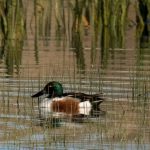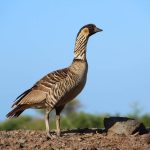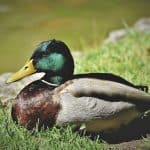Common Name: Red-necked Grebe
Scientific Name: Podiceps grisegena| Size | Diet | Range in Hawaii | Status in Hawaii |
|---|---|---|---|
| 17 in - 19 in. | minnows, perch, and sticklebacks | Kaua'i | Least Concern |
The Red-necked Grebe (Podiceps grisegena) is a stunning water bird species known for its striking red neck and distinctive horn-like feathers on its head. These graceful swimmers are found in freshwater and brackish habitats across North America, Europe, and Asia during their breeding season.
However, during their non-breeding season, they have been spotted as visitors and vagrants in Kaua’i and other parts of the United States. With their unique appearance and impressive diving abilities, Red-necked Grebes are a favorite among birdwatchers and nature enthusiasts. Despite their beauty, these birds face threats from habitat loss and pollution, making conservation efforts crucial for their survival.
Red-necked Grebe
Appearance
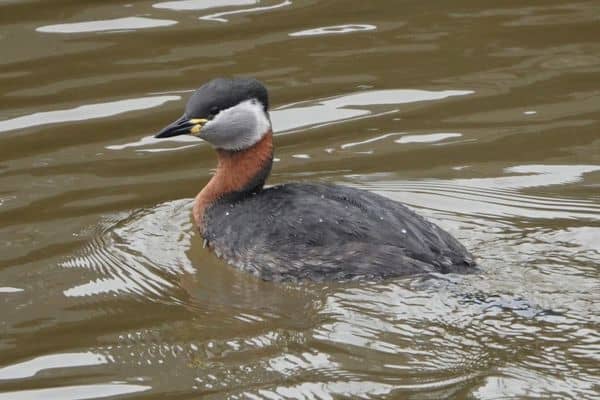
The Red-necked Grebe is a medium-sized water bird with a striking appearance. It has a sleek body, a long, slender neck, and a distinctive red neck and throat during the breeding season. The plumage is mainly dark gray on the upperparts and white on the underparts.
The bill is thin and pointed, and the eyes are red. On average, the Red-necked Grebe measures around 17-19 inches in length.
Diet
The diet of the Red-necked Grebe primarily consists of aquatic prey. They are skilled divers and feed on a variety of small fish, including minnows, perch, and sticklebacks.
They also consume aquatic invertebrates such as insects, crustaceans, and mollusks. The grebes forage underwater, using their agile swimming and diving abilities to capture prey. Their diet is well-adapted to their aquatic habitat, allowing them to sustain their energy and meet their nutritional needs.
Nesting
The Red-necked Grebe builds its nest near bodies of water, typically in dense emergent vegetation or on floating vegetation mats. The nest is constructed using plant materials, such as reeds, grasses, and twigs, woven together to form a floating platform.
The female usually initiates nest construction, while the male assists by bringing additional materials. Red-necked Grebes are known for their elaborate courtship displays, during which they perform synchronized movements and vocalizations to attract a mate.
The female lays a clutch of 3-5 eggs, which both parents take turns incubating for about 23-26 days. After hatching, the chicks are covered in down and are capable of swimming and diving shortly after leaving the nest. The parents continue to provide care and protection to the young until they are able to fend for themselves.
Behavior

The diet of the Red-necked Grebe primarily consists of aquatic prey. They are skilled The Red-necked Grebe exhibits fascinating behaviors that are well-suited to its aquatic lifestyle. These birds are excellent divers, capable of diving underwater for extended periods to search for food.
They propel themselves underwater using their feet, making swift and agile movements. When on the water’s surface, they are skilled swimmers, using their lobed feet to navigate and propel themselves. Red-necked Grebes are known for their elaborate courtship displays, which involve synchronized movements, head-shaking, and vocalizations.
During these displays, they engage in various postures to attract a mate. They are also territorial and defend their nesting sites aggressively, engaging in vocalizations and displays of aggression towards intruders.
Outside of the breeding season, Red-necked Grebes may form loose flocks, often congregating in suitable feeding areas. Overall, their behaviors reflect their adaptation to a life spent primarily on water, where they display remarkable swimming, diving, courtship, and territorial defense skills.
Habitat
The Red-necked Grebe inhabits a variety of aquatic habitats, both freshwater and saltwater. They are commonly found in shallow lakes, ponds, marshes, coastal bays, and estuaries. These birds prefer habitats with ample vegetation and emergent plants, which provide cover and nesting sites.
Red-necked Grebes are often associated with areas that offer a mix of open water for swimming and diving, as well as vegetation for nesting and shelter. They can be found in both inland and coastal regions, depending on the availability of suitable habitats.
Range
According to the Hawaii Bird Records Committee, the Red-necked Grebe is a non-breeding visitor and vagrant in Hawaii. They have been spotted in Kaua’i and other parts of the state during their migration season, which typically occurs between October and April.
While they do not breed in Hawaii, their presence as visitors and vagrants adds to the diversity of bird species found in the state. However, it is important to note that Red-necked Grebes, like many other bird species, face threats from habitat loss and pollution, making conservation efforts crucial for their survival.
Conservation Status
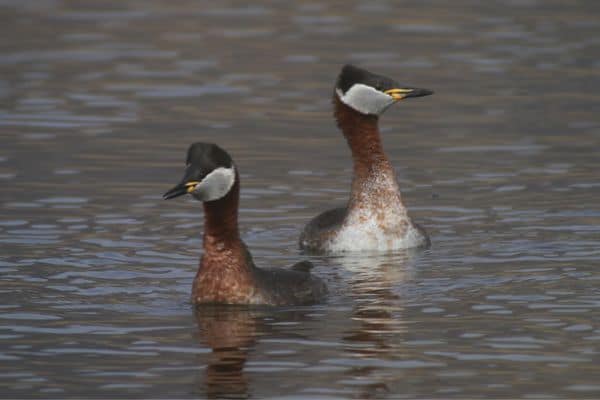
The Red-necked Grebe is currently listed as a species of Least Concern on the IUCN. The Red-necked Grebe holds a conservation status of Least Concern globally according to the IUCN Red List. However, within Europe, it is classified as Vulnerable.
While the species maintains a relatively stable population on a global scale, it faces more significant conservation challenges in European regions. These challenges stem from habitat loss, degradation, and disturbances specific to the European context.
Conservation efforts in Europe focus on addressing these threats, protecting critical habitats, and implementing measures to promote the recovery of Red-necked Grebe populations. The Vulnerable classification highlights the need for targeted conservation actions within the European range to ensure the species’ long-term survival in the region.
Interesting Facts
1. Amazing Courtship Displays
During courtship, Red-necked Grebes engage in synchronized movements, head-shaking, and vocalizations, showcasing their bond and attracting a mate.
2. Inconspicuous Nest
The floating nests of Red-necked Grebes blend seamlessly with the surrounding vegetation, providing camouflage and protection for the eggs and chicks.
3. Talented Divers
These birds are exceptional divers, capable of diving underwater for prolonged periods to search for prey, reaching depths of up to 25 to 30 feet.
4. Vocal Communication
These birds communicate through a variety of calls, including high-pitched whistles, wails, and trills, which are used for territorial defense, courtship, and maintaining contact with their mate and offspring.
Frequently Asked Questions
1. Can Red-necked Grebes fly?
Yes, Red-necked Grebes are capable of flight and often take to the air for migration or to reach suitable breeding or foraging sites.
2. Are Red-necked Grebes good swimmers?
Absolutely! Red-necked Grebes are skilled swimmers, using their lobed feet to navigate and propel themselves in the water.
3. Do Red-necked Grebes migrate?
Yes, Red-necked Grebes are migratory birds, with some individuals traveling long distances to wintering areas.
4. How do Red-necked Grebes communicate?
Red-necked Grebes communicate through a variety of vocalizations, including high-pitched whistles, wails, trills, and chuckling sounds.
5. Do Red-necked Grebes perform any defensive behaviors?
When threatened or disturbed, Red-necked Grebes can display aggressive behaviors, such as vocalizations, head-shaking, and dive displays, to protect their territory or young.

